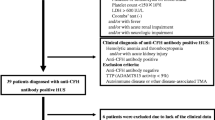Abstract.
The diarrhea-associated form of the hemolytic uremic syndrome (D+ HUS) is characterized by a triad of symptoms, namely thrombocytopenia, hemolytic anemia, and acute renal failure. Histopathological studies of patients with D+ HUS show microthrombi in arterioles and glomeruli of the kidney. Recently, it was suggested that antiphospholipid antibodies might play a pathogenic role in D+ HUS. However, an epiphenomenon could not be excluded. In this study we investigated the relationship between antiphospholipid antibodies and clinical symptoms in 22 patients with the classical form of HUS (D+ HUS). The first sample was obtained on the day of admission. The next samples were taken on day 7 and 14. We measured anticardiolipin (aCL) antibodies (IgM, IgA, and IgG) in the samples using an ELISA. A significant increase in IgM (60%) and IgG (41%) aCL antibodies was seen in patients versus controls. No relationship between aCL antibody levels and severity of renal failure could be demonstrated. These data suggest that antiphospholipid antibodies are increased, but have not been shown to have a role in the pathogenesis of the microangiopathy seen in D+HUS.
Similar content being viewed by others
Author information
Authors and Affiliations
Additional information
Electronic Publication
Rights and permissions
About this article
Cite this article
te Loo, M., van der Velden, T., Onland, W. et al. Anticardiolipin antibodies in D+ hemolytic uremic syndrome. Pediatr Nephrol 17, 1042–1046 (2002). https://doi.org/10.1007/s00467-002-0965-4
Received:
Revised:
Accepted:
Issue Date:
DOI: https://doi.org/10.1007/s00467-002-0965-4




